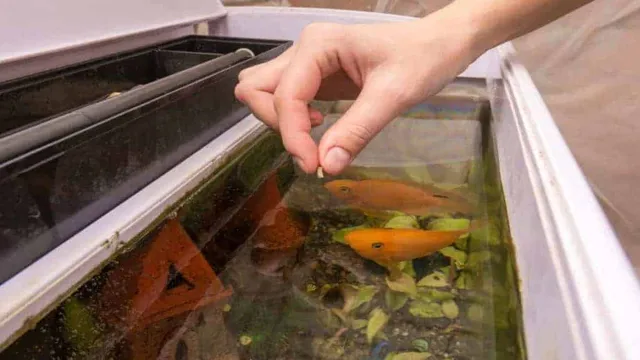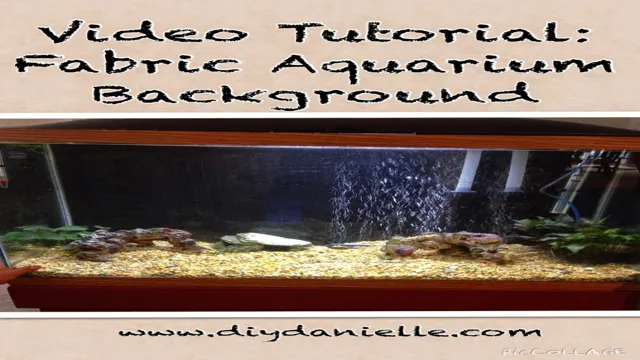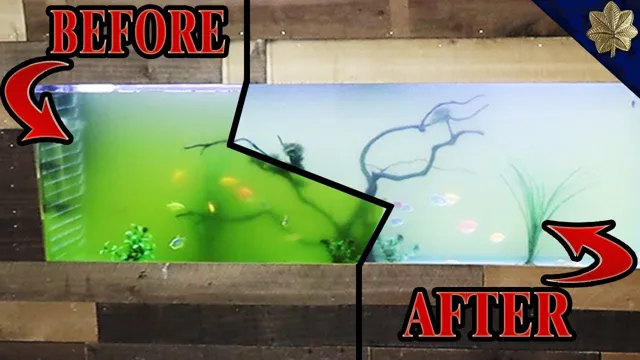Do you want to add that wow factor to your aquarium? Then it’s time to make your aquarium light shimmer! Getting that sparkling effect in your fish tank can turn it into an eye-catching centerpiece in your home. It’s easy to achieve and doesn’t require expensive equipment. The shimmering effect is created by manipulating the light reflecting off the surface of the water.
In this blog, we’ll explore ways to make your aquarium light shimmer using different techniques. Whether you have a small or large aquarium, you’re sure to find tips that will bring out the best in your fish tank. So, let’s dive in and learn more about how to make your aquarium shine!
Understanding Light Distribution
If you’re looking to learn how to make your aquarium light shimmer and enhance the beauty of your aquatic environment, it’s important to understand light distribution. A well-distributed light source plays a crucial role in creating those eye-catching, glimmering movements in your water. To achieve this effect, it’s essential to select a light fixture that has a high-quality reflector.
This reflector allows the light to be evenly distributed throughout your tank, avoiding hot spots or shadowed areas. Additionally, the placement of the light fixture can also impact the shimmer effect. Positioning the light at an angle and using a diffuser can help create the flickering, shimmering light effect that simulates natural sunlight dancing on the water’s surface.
So, when choosing your aquarium light, keep in mind light distribution and reflector quality to ensure your fish and plants thrive while also creating an enchanting visual display.
The Importance of Light
When it comes to lighting, understanding light distribution is essential. The way light is distributed throughout a room can have a significant impact on the atmosphere and overall feel of the space. For instance, a room with even light distribution will feel more welcoming, whereas a room with uneven light might make people feel unwelcome or uncomfortable.
To achieve even light distribution, it’s essential to have good light sources placed strategically in the room. This means having a combination of ceiling fixtures, lamps, and other light sources in different areas of the room. By understanding light distribution, you can create a space that feels comfortable and inviting to both you and your guests.

Light Distribution in Aquariums
Understanding light distribution in aquariums is crucial for providing the necessary light for aquatic plants and animals while avoiding issues such as algae growth and uneven growth patterns. When it comes to light distribution in aquariums, it’s important to consider factors such as the size and depth of the tank, the type of lighting used, and the placement of the light source. For example, if the aquarium is shallow, a single light source may be sufficient, but in deeper tanks, multiple sources may be needed to ensure proper light reaches all areas.
Additionally, different types of lighting, such as LED or fluorescent, can affect how the light is distributed in the tank. Careful consideration should also be given to the placement of the lighting, as too much light in one area can result in algae growth while too little may result in uneven plant growth. By understanding light distribution in aquariums, you can create a healthy and thriving aquatic environment for your fish and plants.
Creating a Shimmer Effect
If you’ve ever looked at a beautiful aquarium, you may have noticed how the light dances and shimmers off the water. It’s a mesmerizing effect that adds to the beauty of the underwater world. If you want to achieve this effect in your own aquarium, there are a few things you can do.
First and foremost, you’ll need to invest in a good quality light fixture that is capable of producing a shimmer effect. LED lights are the most popular choice as they are energy-efficient and customizable. You’ll also need to position the light fixture in a way that creates a rippling effect across the water. (See Also: How to Make an Aquarium Filter Bag: Step-by-Step Guide with DIY Tips)
This can be achieved by angling the light downwards or by installing a wavemaker or powerhead to create water movement. Lastly, it’s important to take into consideration the type of fish and plants in your aquarium. Some fish and plants require more or less light than others so it’s important to research their specific needs before creating your shimmer effect.
With the right combination of lighting, positioning, and aquatic inhabitants, you’ll be able to create a stunning shimmer effect in your aquarium.
Choosing the Right Light Fixtures
When it comes to choosing the right light fixtures, creating a shimmer effect can really add a touch of glamor to your space. To achieve this, you’ll want to look for fixtures that feature materials like glass or crystals, which will reflect the light in a beautiful way. Pendant lights and chandeliers are great options for this, as they usually have multiple light sources that will bounce off of each other, creating a sparkling effect.
You can also consider adding a dimmer switch, which will allow you to adjust the brightness of the lights and create different moods depending on the occasion. Whether you’re looking to add a little extra sparkle to your dining room or create a cozy atmosphere in your bedroom, incorporating a shimmer effect into your lighting design is sure to elevate your space and make it feel more special.
Using a Timer to Mimic Natural Light
If you want to create a shimmer effect with your timer, it’s important to mimic natural light. Mimicking natural light means recreating the pattern of light and dark that occurs naturally throughout the day. You can do this by setting your timer to turn on and off at specific times, increasing and decreasing the amount of light gradually over the course of the day.
By doing so, you can create a gradual transition between light levels that mimics the natural progression of the sun. This can be especially effective for creating a shimmer effect, as it allows the light to shimmer and shift gradually, rather than abruptly turning on and off. So if you want to create a beautiful and natural shimmer effect with your timer, try mimicking natural light and see what kind of effects you can achieve!
Placing Reflective Surfaces in Your Aquarium
If you want to give your aquarium a mesmerizing shimmer effect, try placing reflective surfaces inside the tank. The idea is to reflect light in a way that will create a shimmer on the surface of the water, making it look magical. You can use different types of reflective surfaces such as mirrors or metallic ornaments.
These surfaces will reflect light, intensifying the overall brightness in your aquarium. This can also have a positive impact on your fish and plants, as it simulates a more natural environment by mimicking the way sunlight interacts with the water. However, it’s important to be cautious not to overdo it with the reflective surfaces and make the tank too bright or harsh, which could cause stress on the fish.
So, while adding reflective surfaces can enhance the beauty of your aquarium, moderation is key.
Additional Tips and Tricks
If you want to enhance the look of your aquarium and create a stunning shimmer effect, there are several things you can do to achieve this. Firstly, you should consider using LED lights as they tend to be the most effective and energy efficient. Secondly, you can adjust the angle and positioning of your lights to create the desired effect. (See Also: How Often to Use Aquarium Salt for Goldfish: A Guide for Optimal Health)
Using reflective surfaces can also be helpful in dispersing light more evenly. Another tip is to keep your aquarium clean and well-maintained as any debris or build-up on the glass can hinder light penetration. Additionally, incorporating natural elements such as plants and rocks can enhance the shimmer effect and add a sense of depth to your aquarium.
Lastly, experimenting with different color spectrums can also impact the shimmer effect, so don’t be afraid to play around with your lighting settings to find the perfect look for your aquarium. By following these tips and tricks, you can create a breathtaking and captivating aquarium light shimmer that will showcase your underwater world in all its natural beauty.
Keeping Your Aquarium Clean
When it comes to keeping your aquarium clean, there are a few other tips and tricks you can incorporate into your routine to make sure your fish and plants thrive. One thing you can do is consider using live plants in your aquarium. Not only do they add visual appeal, but they also help to naturally filter and oxygenate the water.
Plus, they provide a healthy place for beneficial bacteria to grow. Additionally, it can be helpful to perform weekly water changes of 10-15% of the total volume to remove excess waste and maintain good water quality. Another tip is to clean your filter media regularly, as a clogged filter can lead to poor water flow and increased toxins.
And finally, consider adding an air stone or bubbler to your aquarium to increase oxygen levels and promote water circulation. By incorporating these additional tips, you can ensure a clean and healthy environment for your aquatic pets.
Adding Fish and Accessories
When it comes to adding fish and accessories to your aquarium, there are a few additional tips and tricks that can really make a difference. Firstly, make sure to research the specific needs of the fish you plan on introducing to your tank. Each species has unique requirements for water temperature, pH levels, and other factors.
Additionally, consider adding live plants to your aquarium. Not only do they add natural beauty, but they also provide oxygen and can help to maintain water quality. When selecting accessories, be mindful of the size and layout of your tank.
You don’t want to overcrowd the space or create areas that are difficult for your fish to swim in. Lastly, consider adding a few hiding spots or decorations to create a more natural environment and reduce stress for your fish. By taking these extra steps and ensuring everything is properly balanced, you can create a thriving and beautiful aquarium for your aquatic pets.
Conclusion
So there you have it, folks! Achieving that mesmerizing aquarium light shimmer isn’t rocket science – it just takes a bit of creativity, experimentation, and patience. Remember to incorporate elements like reflective surfaces, water movement, and varied light sources, and don’t be afraid to try out different combinations to get that perfect aquatic ambiance. Whether you’re a seasoned aquarium enthusiast or a new fish owner, these tips will help you create a stunning aquatic environment that your fish (and visitors) will love! So go ahead and let your shimmer light shine!” (See Also: How to Get Windows 10 Desktop Aquarium Background: DIY Guide for Creating a Stunning Underwater World)
FAQs
What lights are best for creating a shimmer effect in aquariums?
LED lights with high CRI (color rendering index) and a color temperature of around 6500K are ideal for creating a shimmer effect in aquariums.
How can I adjust the intensity of the shimmer effect in my aquarium?
You can adjust the intensity of the shimmer effect by using dimmer switches with your LED lights or by placing a diffuser over the light source.
Can I create a shimmer effect with fluorescent lights?
While it is possible to create a slight shimmer effect with fluorescent lights, it is not as effective as using LED lights with the appropriate color temperature and CRI.
What color temperature should my aquarium lights be for optimal shimmer effect?
A color temperature of around 6500K is ideal for creating a shimmer effect in aquariums.
How much light should I use to create a shimmer effect in my aquarium?
It is recommended to use a moderate level of light, as too much can lead to algae growth and other issues in the aquarium.
What types of fish benefit from a shimmer effect in their environment?
Fish that come from shallow or sunny environments, such as coral reefs, benefit the most from a shimmer effect in their aquarium.
Can I create a shimmer effect without using artificial light?
It is difficult to create a shimmer effect without using artificial light, as it is primarily created by the way light reflects off of the water’s surface.







